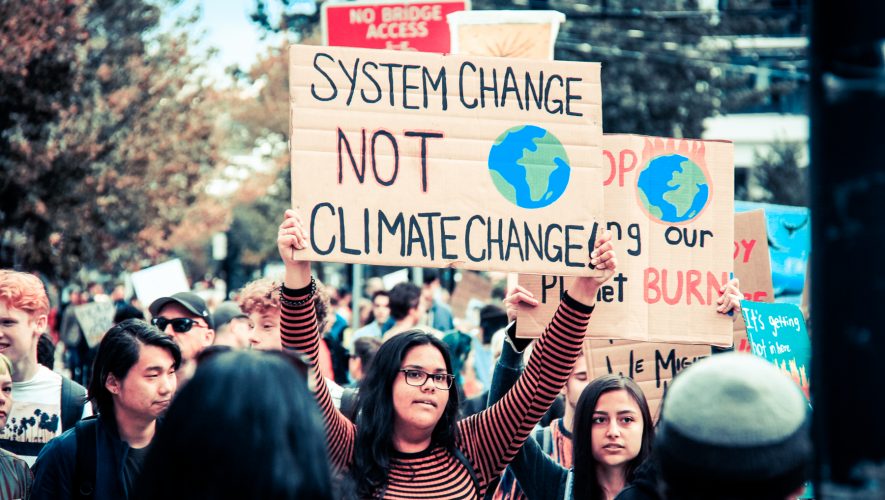Climate change is real. The science is irrefutable. The Earth’s average surface temperature is increasing at an unprecedented rate—almost a full degree Celsius in the past thirty-five years alone. In contrast, when the Earth transitioned out of the last ice age, it took about ten thousand years for temperatures to rise by 4°C. The past decade was the warmest on record; the global average temperature from 2015 to 2019 was 0.2°C higher than the average temperature from 2011 to 2015.
Higher levels of carbon dioxide—a heat-trapping greenhouse gas—in the atmosphere contribute to much of global warming. Carbon dioxide levels remained relatively stable for several thousand years, but began to rise after the Industrial Revolution. From 1850 to 2011, the amount of carbon dioxide in our atmosphere increased from about 280 parts per million to nearly four hundred.
Because of increasing carbon dioxide levels, Arctic sea ice is declining, glaciers are retreating, and sea levels are rising. In February, temperatures in Antarctica hit a record-high 69.4°F. As a result, 120 square miles of ice broke off one of the most endangered glaciers on the continent. As glaciers and sea ice melt, global sea levels rise, bombarding coastal areas with more floods and rainfall. In Bangladesh’s coastal cities, thousands have abandoned their homes and livelihoods to seek refuge in overwhelmingly crowded inland cities.
Rising carbon dioxide levels have also worsened heat waves. In May 2018, a heat wave in Karachi, Pakistan sent temperatures above 110°F and killed twenty-six people. That summer, about a third of Portugal’s meteorological stations detected record-setting temperatures. These heat waves led to extreme weather across Europe, including a drought in the Netherlands and wildfires in Greece. Within the United States, the number and intensity of extreme weather events—from widespread heat waves to hurricanes to wildfires—increased. If global temperatures continue to rise, the frequency of these events will too, impacting billions of people.
The scientific community agrees: almost all long-term warming since 1850 can be attributed to human activity, including greenhouse gas emissions, aerosols, and land use that alters the reflectivity of the Earth’s surface. If the current rate of carbon emissions continues, the world will reach a point of no return. To prevent this, the rise in average global temperature must be kept beneath 1.5°C.
Since the Industrial Revolution, America has emitted more greenhouse gases than any other country, and therefore bears responsibility for leading the charge on environmental protection. Under President Barack Obama, America’s greenhouse emissions decreased—namely because of environmental reforms and regulations such as the Clean Power Plan (CPP), which aimed to “cut carbon pollution from the US power sector by 32 percent from 2005 levels by 2030.” However, emissions are rising once more thanks to the Trump administration’s shift toward harmful environmental policies. After three years of decline, emissions rose by 3.4 percent in 2018—the second-largest one-year jump in two decades.
The United Nations warns that in order to meet the 1.5°C goal, the United States and the rest of the world must make up for years of procrastination with more ambitious reforms. Yet Washington lawmakers and regulators continue to drag their feet, rolling back existing environmental protections and rejecting new ones. Understanding why requires examining four decades’ worth of denial and propaganda.
In 1979, leading scientists warned the members of the American Petroleum Institute—which included ExxonMobil, Shell, and Gulf Oil—that rising carbon dioxide levels would cause climate change. Years prior, Exxon and other members had reached the same conclusion based on their own research. Still, they argued that the science was controversial and worked to prevent the United States from signing the 1998 Kyoto Protocol, which committed developed states to reducing greenhouse gas emissions.
Coal and oil workers—concerned that environmental regulations would harm their livelihoods and convinced by fossil fuel companies that the science was uncertain—pushed their representatives to block reforms. Aspiring Republican politicians opposed environmental regulation to tap into these bases. As these anti-environmental politicians won office, other Republicans realized that they too had to address their constituents’ economic anxiety. The easiest way to do that was to protect the economy over the environment.
Emphasizing economic growth and the possible costs of climate action fit into the larger trend of the Republican Party painting itself as the “fiscally responsible” party. The Democrats, on the other hand, were more likely to emphasize the benefits of environmental regulations. Because of the way the parties framed climate change, a partisan divide formed, altering how politicians talked about environmental policies. It was next to impossible for the Clinton administration to pass meaningful environmental regulations. Under George W. Bush, much of the responsibility for climate legislation fell to the states.
Over time, the parties and their supporters became more divided on climate change. While the number of Americans who acknowledge global warming outnumber those who don’t by more than four to one, there is a clear partisan divide: 83 percent of Democrats believe that climate change is a major threat to the country, while only 27 percent of Republicans do. Moreover, less than half of conservative Republicans think that climatologists should have a major role in policy decisions, compared to 80 percent of liberal Democrats.
Partisan politics contributed to the Obama administration’s struggle to pass legislation. To circumvent the Republican-controlled Senate, Obama issued executive orders to conserve oceans and coasts, protect the Great Lakes, and regulate greenhouse gas emissions at the national level. Opponents criticized the orders as undemocratic, but it was the only way to pass regulations on such a partisan issue.
A 2011 report found that the combined financial benefits of Obama’s Environmental Protection Agency (EPA) rules outweighed the costs by at least two to one. Additionally, the Cross-State Air Pollution rule—which required twenty-seven states to reduce air emissions that crossed state lines—was estimated to save at least thirteen thousand lives and reduce the number of respiratory symptom cases by 820,000 over one year. The EPA published nearly four thousand environmental protection rules during Obama’s two terms.
The Obama administration pursued international progress as well—it was instrumental in the development and implementation of the Paris Climate Agreement, which established international goals for combating climate change and global warming. Throughout 2016, President Obama and his staff brought up the agreement in “virtually all of [their] bilateral and multilateral meetings” to get states to ratify. The first countries to follow America’s lead accounted for nearly half of all global emissions. This encouraged additional countries to sign, giving the agreement the 55 percent threshold necessary for it to take effect.
The Trump administration has tarnished this legacy. Its proposed replacement for the CPP, the Affordable Clean Energy Rule (ACER), is significantly less demanding of fossil fuel-plants. ACER emphasizes efficiency of fuel use rather than reduction of it, pushing power plants to produce more energy using the same amount of fuel, which lowers the energy’s carbon intensity. This would cause 28 percent of power plants to increase their carbon emissions by 2030 compared to enacting no policy.
Furthermore, an EPA analysis predicted that replacing the CPP with ACER could cause an increase of forty thousand tons of sulfur dioxide and twenty-four thousand tons of nitrogen oxide emissions by 2025. Nitrogen oxides are poisonous gases that contribute to the formation of smog, and sulfur dioxide has been linked to breathing issues and to the formation of particulate matter pollution. Consequently, ACER could lead to an additional 1,630 premature deaths and 120,000 asthma attacks by 2030.
As of December 2019, the Trump administration had either rolled back or was in the process of rolling back ninety-five environmental rules. These rollbacks could increase greenhouse gas emissions and cause thousands of deaths from poor air quality. President Trump also pledged to withdraw from the Paris Agreement back in 2017 and began the formal process to pull out in November 2019, despite the fact that most Americans (including a slim majority of Republicans) believe that the country should remain a party. Once the withdrawal is complete in November 2020, the United States will stand as the agreement’s only defector.
Misinformation played a role in all of these decisions. In the three years after the United States ratified the Paris Agreement, five of the largest publicly owned oil and gas companies invested over $1 billion to lobby against climate policy. The National Association of Manufacturers and the US Chamber of Commerce—two of the most successful lobbyists in blocking climate action—campaigned for American withdrawal from the Paris Agreement. Other lobbying groups, such as the Alliance of Automobile Manufacturers, pushed for rollbacks on regulations of methane emissions and fuel economy standards. Exxon, BP, and Chevron donated nearly $2 million combined to Donald Trump’s inaugural committee, indicating their approval of his election and eagerness to invest in his administration.
As long as oil and gas executives can spend money lobbying legislators, regulations will stall. These executives know that meaningful government regulation on climate change—putting stricter caps on emissions, protecting areas from mining and drilling, strengthening protections for endangered species—could hurt their profits.
To get politicians to pass legislation that protects our planet, the influence of oil and gas companies must be limited. Currently, these corporations can donate however much they want to further their political interests. This ability is based on two Supreme Court decisions—Buckley v. Valeo (1976), which held that limits on independent campaign expenditures are unconstitutional, and Citizens United v. Federal Election Commission (2010), which allows for unlimited independent expenditures by corporations and unions. This allows fossil fuel companies to spend millions of dollars—far more than most individuals can muster—to elect their preferred candidates.
The overturning of either Buckley or Citizens United is highly unlikely, especially with a conservative majority on the Supreme Court. However, many 2020 Democratic presidential candidates have taken steps against “dark money” contributions—nineteen campaigns refused money from the fossil fuel industry and nine rejected donations from Super Political Action Committees. These actions, which come from candidates’ desire to prove that they can’t be bought by corporations, are admirable, but in a general election against Donald Trump, grassroots donations may not be enough. While Democratic candidates use their funds to compete against one another, Trump can build up all the money—including fossil fuel money—he’ll need to outspend the Democratic nominee in the general. The Trump reelection campaign has already received over $1.2 million from the oil and gas industry.
The only way to get oil and gas money out of politics and pass legislation to protect our planet is by electing politicians who care more about the environment than courting the fossil fuel industry. Many of the 2020 Democratic candidates have pledged to advocate the overturning of Citizens United via a constitutional amendment. Some have called for other forms of campaign finance reform, including strengthening the Federal Election Commission to reduce gridlock and enforce campaign finance laws. A different presidential administration could also rejoin the Paris Agreement and re-enact many of the environmental regulations that Trump has removed. These are small steps, but they are an important foundation for fighting oil and gas companies and protecting the Earth.
Climate change won’t go away on its own. Fighting it will take a worldwide coalition of states, leaders, and the general public. For decades, politicians and fossil fuel executives have put the health of the planet and its people on the line in order to line their pockets. We need people who will confront the system that has resulted in global environmental problems. Keeping the Earth from warming past the point of no return will require more than pledging to avoid disposable straws. It will require us to dismantle the fossil fuel industry’s influence in our politics. It will require us to speak out, be loud, and refuse to back down.
The world is counting on us.



